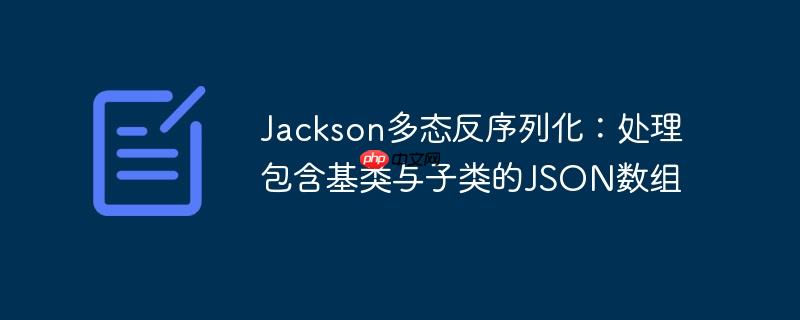
在java开发中,我们经常需要处理来自外部服务或文件中的json数据。当json数组中包含不同类型但有继承关系的java对象时,例如一个包含car和truck(truck继承自car)实例的数组,并尝试将其反序列化为list<car>时,jackson的默认行为可能会导致问题。
考虑以下Java类结构:
public class Car {
private String make;
private String model;
private short year;
private String bodyStyle;
private String engineType;
private int horsepower;
// 省略setter和getter
// 为了演示,添加一个toString方法
@Override
public String toString() {
return "Car{" +
"make='" + make + '\'' +
", model='" + model + '\'' +
", year=" + year +
", bodyStyle='" + bodyStyle + '\'' +
", engineType='" + engineType + '\'' +
", horsepower=" + horsepower +
'}';
}
// 构造函数
public Car() {}
public Car(String make, String model, short year, String bodyStyle, String engineType, int horsepower) {
this.make = make;
this.model = model;
this.year = year;
this.bodyStyle = bodyStyle;
this.engineType = engineType;
this.horsepower = horsepower;
}
// Getters and Setters
public String getMake() { return make; }
public void setMake(String make) { this.make = make; }
public String getModel() { return model; }
public void setModel(String model) { this.model = model; }
public short getYear() { return year; }
public void setYear(short year) { this.year = year; }
public String getBodyStyle() { return bodyStyle; }
public void setBodyStyle(String bodyStyle) { this.bodyStyle = bodyStyle; }
public String getEngineType() { return engineType; }
public void setEngineType(String engineType) { this.engineType = engineType; }
public int getHorsepower() { return horsepower; }
public void setHorsepower(int horsepower) { this.horsepower = horsepower; }
}
public class Truck extends Car {
private double maxLoad;
private double clearance;
// 省略setter和getter
// 为了演示,添加一个toString方法
@Override
public String toString() {
return "Truck{" +
"make='" + getMake() + '\'' +
", model='" + getModel() + '\'' +
", year=" + getYear() +
", bodyStyle='" + getBodyStyle() + '\'' +
", engineType='" + getEngineType() + '\'' +
", horsepower=" + getHorsepower() +
", maxLoad=" + maxLoad +
", clearance=" + clearance +
'}';
}
// 构造函数
public Truck() {}
public Truck(String make, String model, short year, String bodyStyle, String engineType, int horsepower, double maxLoad, double clearance) {
super(make, model, year, bodyStyle, engineType, horsepower);
this.maxLoad = maxLoad;
this.clearance = clearance;
}
// Getters and Setters
public double getMaxLoad() { return maxLoad; }
public void setMaxLoad(double maxLoad) { this.maxLoad = maxLoad; }
public double getClearance() { return clearance; }
public void setClearance(double clearance) { this.clearance = clearance; }
}以及对应的JSON数据示例:
[
{
"make": "Ford",
"model": "Focus",
"year": 2018,
"engineType": "T4",
"bodyStyle": "hatchback",
"horsepower": 225
},
{
"make": "Toyota",
"model": "Tacoma",
"year": 2021,
"engineType": "V6",
"bodyStyle": "pickup",
"horsepower": 278,
"maxLoad": 1050,
"clearance": 9.4
},
{
"make": "Ford",
"model": "T150",
"year": 2017,
"horsepower": 450,
"bodyStyle": "pickup",
"maxLoad": 2320,
"clearance": 8.4
}
]当我们尝试使用ObjectMapper将上述JSON反序列化为List<Car>时,会遇到com.fasterxml.jackson.databind.exc.UnrecognizedPropertyException异常,因为Car类不包含maxLoad或clearance等Truck特有的属性。Jackson在尝试将一个实际是Truck的JSON对象映射到Car类型时,无法识别这些额外属性。
Jackson提供了强大的多态性反序列化机制,允许根据JSON数据的内容动态地确定要创建的Java对象类型。这主要通过@JsonTypeInfo和@JsonSubTypes这两个注解来实现。
@JsonTypeInfo用于指定多态类型信息的处理方式。在本场景中,我们将使用Id.DEDUCTION策略。
@JsonSubTypes用于列出基类的所有已知子类型。Jackson会根据这些子类型的信息,结合@JsonTypeInfo的策略来执行类型推断。
为了解决上述问题,我们需要在基类Car上添加这两个注解:
import com.fasterxml.jackson.annotation.JsonSubTypes;
import com.fasterxml.jackson.annotation.JsonTypeInfo;
@JsonTypeInfo(use = JsonTypeInfo.Id.DEDUCTION, defaultImpl = Car.class)
@JsonSubTypes({
@JsonSubTypes.Type(value = Truck.class)
})
public class Car {
private String make;
private String model;
private short year;
private String bodyStyle;
private String engineType;
private int horsepower;
// 省略setter和getter以及toString()和构造函数,同上
// ...
}
public class Truck extends Car {
private double maxLoad;
private double clearance;
// 省略setter和getter以及toString()和构造函数,同上
// ...
}现在,我们可以使用更新后的Car和Truck类进行反序列化。
import com.fasterxml.jackson.core.type.TypeReference;
import com.fasterxml.jackson.databind.ObjectMapper;
import java.io.IOException;
import java.io.InputStream;
import java.util.List;
public class PolymorphicDeserializationDemo {
private static final ObjectMapper mapper = new ObjectMapper();
public static void main(String[] args) {
// 假设cars.json包含前面提到的JSON数据
InputStream src = PolymorphicDeserializationDemo.class.getClassLoader().getResourceAsStream("cars.json");
if (src == null) {
System.err.println("Error: cars.json not found in classpath.");
return;
}
try {
// 反序列化为List<Car>
List<Car> vehicles = mapper.readValue(src, new TypeReference<List<Car>>() {});
System.out.println("Deserialized Vehicles:");
for (Car vehicle : vehicles) {
System.out.println("Type: " + vehicle.getClass().getSimpleName() + ", Details: " + vehicle);
}
} catch (IOException e) {
e.printStackTrace();
} finally {
try {
if (src != null) {
src.close();
}
} catch (IOException e) {
e.printStackTrace();
}
}
}
}运行上述代码,输出将不再是UnrecognizedPropertyException,而是成功地打印出每个对象的实际类型和内容:
Deserialized Vehicles:
Type: Car, Details: Car{make='Ford', model='Focus', year=2018, bodyStyle='hatchback', engineType='T4', horsepower=225}
Type: Truck, Details: Truck{make='Toyota', model='Tacoma', year=2021, bodyStyle='pickup', engineType='V6', horsepower=278, maxLoad=1050.0, clearance=9.4}
Type: Truck, Details: Truck{make='Ford', model='T150', year=2017, bodyStyle='pickup', engineType='null', horsepower=450, maxLoad=2320.0, clearance=8.4}可以看到,Focus被正确地反序列化为Car类型,而Tacoma和T150则被正确地反序列化为Truck类型,且所有对象都存储在List<Car>中。
当Jackson遇到一个JSON对象时,它会按照以下逻辑进行处理:
这种机制使得Jackson能够智能地处理JSON数据中的多态性,无需在JSON中显式地包含类型标识符(如@class字段),从而保持JSON的简洁性。
通过巧妙地使用Jackson的@JsonTypeInfo和@JsonSubTypes注解,我们可以优雅地解决JSON数组中包含混合继承关系对象时的反序列化问题。Id.DEDUCTION策略结合defaultImpl提供了一种无需修改JSON结构即可实现多态性反序列化的强大方法,使得代码更加健壮和灵活,能够适应不同复杂度的JSON数据场景。理解并掌握这些注解的使用,是高效处理复杂JSON数据结构的关键技能。
以上就是Jackson多态反序列化:处理包含基类与子类的JSON数组的详细内容,更多请关注php中文网其它相关文章!

每个人都需要一台速度更快、更稳定的 PC。随着时间的推移,垃圾文件、旧注册表数据和不必要的后台进程会占用资源并降低性能。幸运的是,许多工具可以让 Windows 保持平稳运行。

Copyright 2014-2025 https://www.php.cn/ All Rights Reserved | php.cn | 湘ICP备2023035733号